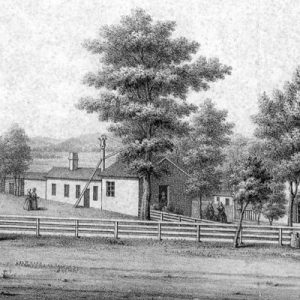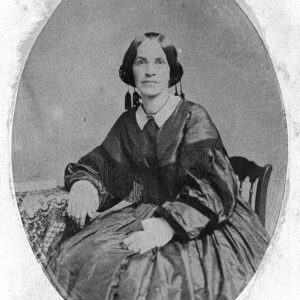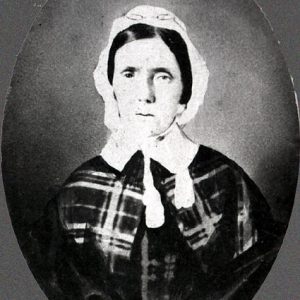calsfoundation@cals.org
Sophia Sawyer (1792–1854)
Sophia Sawyer, an educator whose calling was to teach the Cherokee, founded the Fayetteville Female Seminary in 1839. This tireless educator was associated with the American Board of Commissioners for Foreign Missions of the Congregational Church.
Sophia Sawyer was born May 4 or 5, 1792, in Fitchburg, Massachusetts. Little is known of her parents, save for the fact that they were extremely poor farmers who eventually bought a farm in New Hampshire. She never married.
Dr. Seth Payson, a Congregational clergyman from Rindge, New Hampshire, took Sawyer into his home as a housemaid after her parents died and sent her to school. Sawyer gained teaching experience in the Payson household, teaching basic education during the summer at Rindge but needed credentials to make teaching a career. Payson and a family named Raymond helped fund her studies at Reverend Joseph Emerson’s female seminary in Byfield, Massachusetts, where she graduated in 1822 or 1823 with the qualifications necessary to teach primary school.
By 1823, Sawyer had applied to be a missionary teacher with the American Board of Commissioners for Foreign Missions and was teaching in a Cherokee Indian mission school in Georgia. For the next fourteen years, she taught in missions with the Cherokee, first in Tennessee and then in Georgia. Sawyer was zealous and uncompromising in her mission as a teacher. She broke the law in Georgia by teaching two African-American slaves owned by Cherokee. Although other educators had been jailed in Georgia for the same offense, Sawyer escaped arrest by telling the soldiers who came for her that, since she was on Indian territory, she would obey only Indian laws.
In the fall of 1837, after a trip to New Hampshire to visit friends and recover from an illness, Sawyer accompanied John Ridge and his family to the new Indian Territory (present-day Oklahoma). Ridge, a Georgia plantation owner, was one of four Indian leaders who had led the Cherokee “Treaty Party” and signed a removal treaty at New Echota in 1835. Sawyer had taught the Ridge children in Georgia. The Ridge family settled at Honey Creek, on the border near present-day Southwest City, Missouri, and Sawyer established a school in the Ridge home.
In 1839, the John Ross party, a rival Cherokee faction that had come to power during the mass removal of 1838 (Trail of Tears), murdered John Ridge. Sawyer considered maintaining her school but was concerned that Ridge’s widow, Sarah Bird Northrup Ridge, was “sinking under the weight of sorrow”; Sawyer also had reason to be concerned for their mutual safety. So she moved with the Ridge family as they fled to Fayetteville (Washington County). They arrived in Fayetteville on July 1, 1839, and Sawyer began plans to found a new school. Her first students when the school opened later that year were fourteen Cherokee girls, daughters of prominent Indian families—the Drew, Ridge, Ross, Adair, and Starr families.
Sawyer’s first classes were held in a log structure in Fayetteville. From there, she progressed to the second floor of a retail store. According to legend, a thespian society rented the lower floor of the building, and Sawyer’s diligent supervision of her pupils was intensified to protect them from corruption by the lax morals of the actors.
By October 1840, Sawyer was held in such high regard that Judge David Walker and his wife, Jane, deeded her a tract of land upon which to construct a permanent building. Her school’s enrollment had grown to fifty pupils, including young boys as day students. She continued to report to the American Board of Missions, but her school was financially self-sustaining. For the first eight years, she taught all academic subjects herself.
The Fayetteville Female Seminary enjoyed an excellent reputation. While Sawyer was limited by her certification to teaching the primary grades, she hired other teachers for advanced subjects. Among the instructors she hired was Reverend Cephus Washburn, a fellow missionary to the Cherokee who had founded the Dwight Mission in 1820. In 1848, Governor Thomas S. Drew was a guest at the commencement ceremonies. Sawyer took a great personal interest in her students and was known to have personally nursed ill students in the respectable homes where they boarded.
Sawyer died from tuberculosis on February 22, 1854, in Fayetteville. She was initially buried on her school grounds but was later re-interred in Fayetteville’s historic Evergreen Cemetery. After her death, Lucretia Foster Smith took over the seminary. Five years after her death, the seminary was incorporated, and it remained open until 1862, when the school was torched following the Battle of Prairie Grove.
For additional information:
Campbell, William S. One Hundred Years of Fayetteville 1828–1928. Fayetteville, AR: Washington County Historical Society, 1977.
Castelow, Teri L. “‘Behold Me and This Great Babylon I Have Built’: The Life and Work of Sophia Sawyer, 19th Century Missionary and Teacher among the Cherokees.” Ph.D. diss., Florida State University, 2005. Online at https://diginole.lib.fsu.edu/islandora/object/fsu:182263/datastream/PDF/view (accessed August 17, 2023).
———. “Miss Sophia Sawyer: Founder of the Fayetteville Female Seminary.” Arkansas Historical Quarterly 68 (Summer 2009): 176–200.
Hirschten, Sean Michael. “‘Made Useful by the Grace of God’: Sophia Sawyer’s Life as a Missionary among the Cherokees, 1823–1844.” MA thesis, Western Carolina University, 2006.
Sophia Sawyer Papers. Duane N. Diedrich Collection. William M. Clements Library, University of Michigan, Ann Arbor, Michigan.
Cassandra McCraw
University of Arkansas at Fayetteville
Staff of the Encyclopedia of Arkansas History & Culture
This entry, originally published in Arkansas Biography: A Collection of Notable Lives, appears in the CALS Encyclopedia of Arkansas in an altered form. Arkansas Biography is available from the University of Arkansas Press.
 Fayetteville Female Seminary
Fayetteville Female Seminary  Lucretia Foster
Lucretia Foster  Sophia Sawyer
Sophia Sawyer 




Comments
No comments on this entry yet.